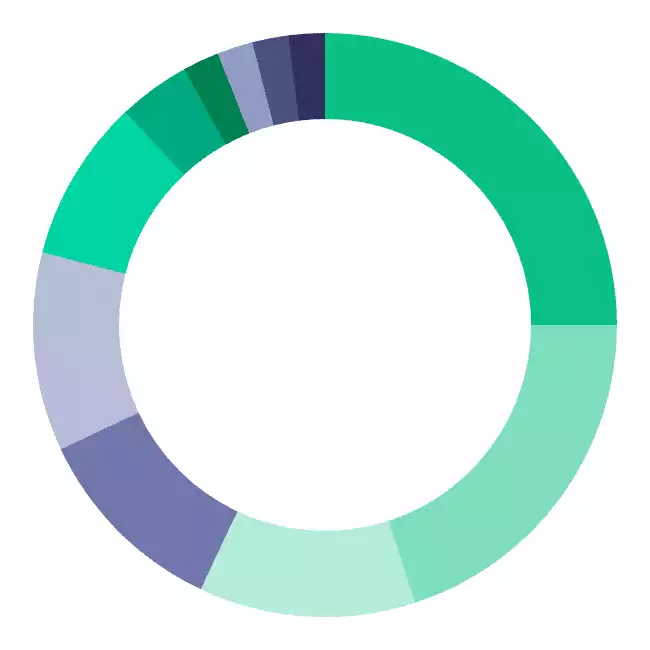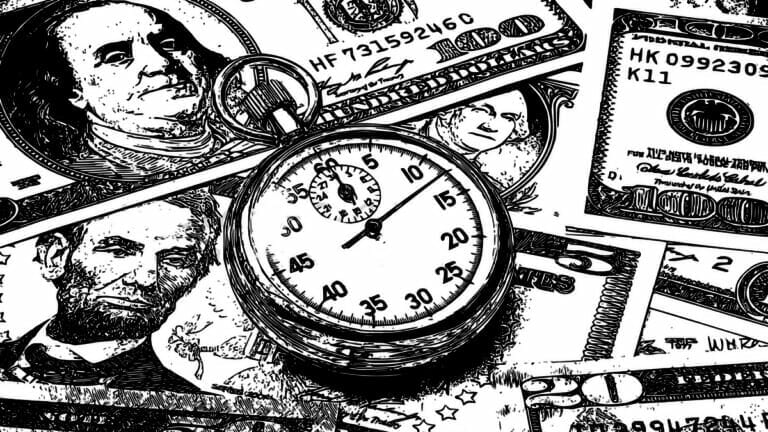- High-Yield Savings Accounts
- High-Yield Money Market Account
- Money Market Funds
- Certificates of Deposit (CDs)
- Treasury Bonds
- Treasury Inflation-Protected Securities (TIPs)
- Treasury Notes
- Treasury Bills
- Government Bond Funds
- Municipal Bond Funds
- Corporate Bonds
- REITs
- Mutual Funds
- Exchange-Traded Funds (ETFs)
- Index Funds
- Dividend Stocks
If you’ve been paying attention to the outside world, it’s a scary time for everyone. The stock market seems to jump all over the place daily. Some people have a high-risk tolerance, but a lot of us just want to know how we can ride out this storm with some low-risk investments.
But what are safe investments?
If you’ve been reading Listen Money Matters for a while you know how we feel about having an emergency fund and a cash cushion. We’re also investing for the long haul so we advocate a buy and hold strategy.
That means we generally don’t worry about market fluctuations. After a record bull run, many investors are experiencing a market downturn for the first time.
You may have found your portfolio too aggressive, and you’re looking for some low-risk options to diversify. Others are nearing their retirement date and are looking for what to do with their nest egg.
We’ll talk about our investment strategy as well as some different types of investments to help get you to the other side while maximizing returns.
Even if your portfolio has lost half its face value, you still own the same amount of shares. You don’t realize any losses unless you sell.
We recommend you take a deep breath and continue to invest whether the market happens to be up or down.
That said, here are some safe investment options if stock market losses are causing you to lose sleep.
Rule of Thumb: Low-risk investments typically offer a lower rate of return while reducing losses. High-risk investments yield larger long-term returns, but carry increased short-term volatility along the way.
How to Pick Safe Investments
When determining which type of investment option you’re interested in, it’s important to think about your goals. Needing cash-flow and liquidity will lead you down a different path than if you only want a safe place to park your money for the next thirty years.
As with any investment, it’s a balance between risk and reward. The higher the risk, the greater likely the returns, but there’s also a substantial chance for big losses.
If you’re in the growth stage of your wealth-building, stocks and stock funds can offer a much greater return over the long haul than the other options listed.
For someone several decades from retirement, options 12-15 are probably best. If you’re more concerned with preserving what you already have, then options 1-11 might make more sense.
Even if a large percentage of your portfolio was in Boeing, you don’t realize a loss unless you sell at the bottom. That’s why we’re so adamant that a buy and hold strategy is best.
Timing the market is hard to do because you have to be right twice. If you already have money in the stock market, the safest thing you can do is leave it alone.
Talk to your financial advisor about which option is best for you. It’s critical not to panic. The stock market will experience multiple bear markets and bull markets during your lifetime. Earn more than you spend, invest the rest, and you’ll be fine.
Safe Investments to Consider
These investments flow from safe to risky. They’re ordered based on expected return, protection, and liquidity. Numbers 1-11 carry the least risk while 12-16 are slightly riskier options.
The absolute safest investment option is to put your money in a high-yield savings account. Many online bank accounts pay between a 1-2% interest rate for banking with them.
This is a guaranteed return and the safest place to invest.
High-yield savings accounts are backed by the Federal Deposit Insurance Corporation (FDIC) up to $250,000, and protect you if your bank goes under.
The downside is your money isn’t going to grow substantially. The rate of return will barely keep up with inflation.
But, your money won’t lose half its face value overnight and your return will be a fixed rate. If you have a higher risk tolerance, some of these other options yield higher returns on a longer timeline, but if you’re looking for the safest option, this is it.
CIT Bank offers a high interest rate and you can get up to $300 when you open an account.
CIT is an online bank with some of the highest interest-earning savings and money market accounts available. They even offer no-penalty CDs. CIT also features eChecking and loan servicing. They're FDIC-insured up to $250,000.
Not to be confused with a money market fund, a money market account is basically a savings account that earns interest and is offered by a financial institution.
These are one of the safest places to invest money because, much like a high-yield savings account, they’re also FDIC-insured up to $250,000.
Money market accounts offer a safe investment with easy access. Many will allow you to access the funds with either checks or a debit card.
Money market funds are a type of mutual fund. They invest in short-term debt, cash equivalents, and even cash. Not quite as safe, but they offer a higher return and are extremely low-risk.
One of the main benefits of money market funds is their liquidity. These are a great place to park money while you’re waiting to invest. Leaving all your money in a money market fund is not a great long-term strategy, but it can be a safe haven during tough times.
A money market fund is a great place to store cash that you want to have ready to invest at a moment’s notice. We refer to this as your opportunity fund.
Certificates of deposit are a very low-risk investment option.
How CDs work:
You agree to give the bank or credit union some of your money for a certain period of time. Generally, the longer you agree to leave your money in the bank, the higher interest rate you’ll receive. Once that time period is up, they pay you your principal plus the agreed-upon interest rate.
Certificates of deposit are considered a very safe investment because they’re backed by the (FDIC) for up to $250,000. This means if the bank isn’t able to repay you, the FDIC will.
The upside to certificates of deposit is they tend to earn a higher interest rate than leaving your money in a savings account or money market account. The downside is you aren’t able to access your money until the specified time without paying an early withdrawal penalty.
A certificate of deposit can offer a higher return than a money market account without incurring any additional risk, but you lose liquidity.
Building a CD ladder can be a superior investment strategy.
Get our best strategies, tools, and support sent straight to your inbox.
Treasury Securities
There are three types of Treasury Securities: Treasury Bonds, Treasury Notes (T-Notes), and Treasury Bills (T-Bills). There are also TIPs, which are a type of Treasury Bond.
Treasury bonds are bonds issued by the Federal Government. They have a maturity date of 30 years and pay interest twice per year. Once the bond reaches maturity it pays the market value to the holder.
Treasury Inflation-Protected Securities are a type of U.S. Treasury bond. Their purpose is to protect investors against inflation rates.
These bonds have U.S. government backing and are indexed to inflation. They pay the investors a fixed interest rate while the bond’s value adjusts with the current rate.
Treasury notes have maturity dates of two, three, five, seven, and ten years and the holder earns interest payments every six months at a fixed rate. Once they mature, the U.S. government will pay the full face value of the note.
Treasury bills have a maturity date of one year or less. They technically don’t earn interest but they’re sold at a discount. Once they reach maturity, the U.S. government will pay the market value for them.
Treasury securities are bonds backed by the government for government debt. They are backed by the U.S. government and are a great option if you have more than $250,000 and you’re not looking to access the money anytime soon.
The downside to Treasury securities is you CANNOT take the money out early, even for a penalty. You can sell them on a secondary market but you can’t directly access before maturity.
Bonds and Bond Funds
There are many different types of bonds you can invest in. A bond is essentially an IOU where you loan money to the issuer and they agree to give you a set number of payments over a fixed time period.
At the end of this time, the bond reaches its maturity date and the full amount of your investment is returned to you.
Bonds work as an excellent counterweight to stocks. Stocks are like the sails of a ship, they get it moving quickly. This can be a good thing in a bull market, but you can find yourself off course during a bear market.
Bonds are a safe investment to balance your portfolio during uncertain times. Think of them like an anchor that keeps your ship from fluctuating wildly during the ups and downs of the stock market.
Note: Various types of bonds include municipal bonds, U.S. Savings Bonds, and Corporate Bonds.
Bonds can be bought and sold on the open market or privately. Typically, you sacrifice a higher rate of return for taking on a lower-risk when choosing bonds instead of stocks.
Bonds are rated by Standard & Poor’s, Moody’s, and Fitch.
The ratings will range but AAA to Baa are considered investment grade. Bonds with ratings of BB or Ba and below are considered junk bonds.
The bond rating helps you determine how likely the issuer is to pay back the bond or default. The lower grade generally offers higher yields, but at a greater risk of default.
You can purchase individual bonds or bond funds. Bond funds work similarly to a mutual fund for stocks.
Government Bond Funds are mutual funds that invest in debt securities. These are backed by the U.S. government and used as a way to pay off debt and fund projects.
Government bond funds are the safest of the listed bonds to invest in, but generally offer the lowest returns.
If we could time the stock market, we’d all be millionaires. But we can't.
Tweet ThisMunicipal Bonds are debt obligations issued by state and local governments. They are flexible as you can buy and sell shares every day.
The interest earned is typically not taxed federally and may not be taxed at the state or local level depending on the bond. Municipal bonds are a good middle-ground if you want higher returns than government bonds, but you’d prefer lower-risk than corporate bonds.
Corporate Bonds are bonds raised by companies. A company would issue a bond if they’re trying to raise capital. These are riskier than municipal or government bonds but they also generate higher returns.
Real Estate Investment Trusts
Real estate investment trusts (REITs) let you invest in companies that own or manage real estate. This is a great option if you want to dip your toes into the real estate market, but don’t want the hassle or time commitment of owning an individual property.
Similar to how individual stocks compare to mutual funds, REITs are less risky than owning a single property because one bad investment deal won’t sink the entire ship.
You likely won’t get the returns that you would by directly investing in real estate, but its entirely passive and lower risk.
Read our Getting Started In Real Estate and REIT Investing guides for a closer look.
Diversify into income-producing real estate without the dramatics of actual tenants. Fundrise eREITs are a diverse family of funds, each of which pursues a focused real estate investment strategy.
Disclosure: When you sign up with this link, we earn a commission. All opinions are our own. I am investing with Fundrise
Index Funds, Mutual Funds, and Exchange Traded Funds (ETFs)
Investing in index funds, mutual funds, or ETFs is generally a lot safer than investing in individual companies such as Luckin (LK) or Boeing (BA).
The reason is they include multiple companies so they’re less prone to large swings.
Mutual funds are investments that pool money from investors to purchase stocks, bonds, and other types of investments. A portfolio manager decides where and when to invest the money.
The manager is paid a fee, which gives mutual funds a higher expense ratio over ETFs or index funds.
ETFs are like a basket of stocks, bonds, or commodities you can buy and sell through a broker. ETFs usually track an index.
The downside to ETFs is they cost more to trade than mutual funds. The upside is their expense ratios are less than actively-managed mutual funds.
An index fund is a type of mutual fund but instead of paying a portfolio manager to choose where and when to invest, an index fund simplifies things by following a given index.
For example, the S&P 500 Index invests in companies that are in the S&P 500. The difference between these three funds is a point of confusion for many.
Index funds are technically mutual funds while ETFs are not. ETFs are traded more like stocks even though ETFs generally track an index.
Deep Dives: For a closer look, check out these detailed posts about index funds, index fund myths, and the differences between mutual funds and ETFs.
Stocks
This is the riskiest of the options listed but can provide excellent returns and stable income. Dividend-paying stocks are best for those with a higher-risk tolerance who want passive cash flow.
Relying solely on dividend-paying stocks is risky unless you’re well-diversified. Boeing shares, for instance, recently plunged from $340 per share in mid-February down to $95.00 per share by March 20th due to the Coronavirus.
While everyone was hit hard, most mutual funds only fell around 30%.
To limit your risk, invest in dividend-paying stocks with a long track record. They’ve weathered storms before and are more likely to continue paying even in bear markets.
Dividend-paying stocks are riskier, but with great risk comes great reward. If you diversify your portfolio, you can create your own mutual fund.
Investing in individual dividend stocks gives you the highest potential for growth but also leaves you open to large market swings.
Or, you can invest in a dividend fund through a brokerage firm like Vanguard. For example, its dividend appreciation fund, VDADX, tracks a benchmark of U.S. companies that have historically increased its dividends annually.
This is an index fund of the most consistent dividend-paying companies in the S&P 500. It has historically outperformed the S&P 500 long-term. Over the past 10 years, it has returned 10.98% on an average annual basis whereas the S&P 500 only returned 10.53% during that same period.
The benefit of dividend-paying stocks over non-dividend-paying stocks is you’re generally guaranteed a payout four times per year.








